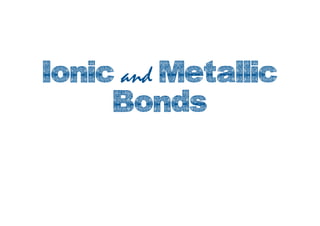
Understanding Ionic and Metallic Bonds
- 2. Understanding Ions Remember: the atoms of two or more nonmetals form compounds by sharing valence electrons. This is called a covalent bond. However, when a metal and a nonmetal bond, they do not share electrons. Instead, one or more valence electrons transfers from the metal atom to the nonmetal atom.
- 6. Understanding Ions After electrons transfer, the atoms bond and form a chemically stable compound. Transferring valence electrons results in atoms with the same number of valence electrons as a noble gas.
- 7. Understanding Ions When an atom loses or gains a valence electron, it becomes an ion. An ion is an atom that is no longer neutral because it has lost or gained valence electrons. 11 protons 11 electrons (neutral) after losing one electron= but 11 protons 10 electrons (positively charged) ∴ Na+ 11 Na Sodium
- 8. Understanding Ions 17 protons 17 electrons (neutral) after gaining one electron= but 17 protons 18 electrons (negatively charged) ∴ Cl- 17 Cl Chlorine When an atom loses or gains a valence electron, it becomes an ion. An ion is an atom that is no longer neutral because it has lost or gained valence electrons.
- 9. Understanding Ions Cl- Cl The sodium ion and the chlorine ion are more stable than the neutral sodium and chlorine atoms. Na+ Na More Stable
- 10. Cl- The attraction between positively and negatively charged ions in an ionic compound is an ionic bond. Na+ ionic bonding Ionic Bonds
- 11. Ionic Bonds The ions of ionic compounds are strongly attracted to each other. As a result, ionic compounds are usually solid and brittle at room temperature. They have relatively high melting and boiling points. Water that contains dissolved ionic compounds is a good conductor of electricity. This is because an electrical charge can pass from ion to ion in the solution. Na+ Cl-
- 12. Covalent vs.Ionic In a covalent bond, two or more nonmetal atoms share electrons and form a unit, or molecule. Covalent compounds are made up of many molecules. However, when nonmetal ions bond to metal ions in an ionic compound, there are no molecules. Instead, there is a large collection of ions with opposite charges. The ions are all attracted to each other and are held together by ionic bonds.
- 14. Metallic Bonding Metal atoms typically lose valence electrons when forming compounds. Metal atoms form compounds with one another by combining, or pooling, their valence electrons. Metallic bond is a bond formed when many metal atoms share their pooled valence electrons.
- 15. Metallic Bonding In silver (Ag), atoms lose their valence electrons and become positive ions. The negatively charged valence electrons move from ion to ion. Valence electrons in metals do not bond to one atom. Instead, a “sea of electrons” surrounds the positive ions.
- 16. Metallic Bonding
- 17. Metallic Bonding Metals are good conductors of thermal energy and electricity, because the valence electrons can move from ion to ion. When a metal is hammered into a sheet or drawn into a wire, it does not break. The metal ions can slide past one another in the electron sea and move to new positions. Metals are shiny because the valence electrons at the surface interact with light.
- 18. Summary
- 19. Summary